The Bile Collection Bags Market is estimated to be valued at USD 41.1 billion in 2025 and is projected to reach USD 70.2 billion by 2035, registering a compound annual growth rate (CAGR) of 5.5% over the forecast period.
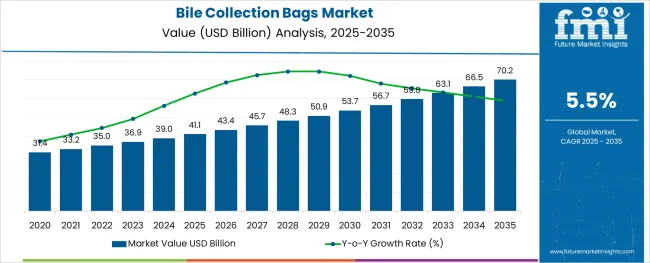
The bile collection bags market is expanding steadily, supported by rising surgical volumes, particularly in hepatobiliary and gastrointestinal procedures, and an aging population with a higher prevalence of gallbladder and liver-related conditions. The growing focus on post-operative care and minimally invasive surgical interventions is increasing the need for reliable fluid collection systems, of which bile collection bags form a critical component. Technological advancements in material biocompatibility, antimicrobial coatings, and leak-proof sealing mechanisms have improved the performance and safety of these bags.
In addition, hospital infection control protocols and strict patient hygiene standards are driving procurement of sterile, disposable, and easy-to-monitor bag systems. The market is also witnessing a shift toward latex-free and patient-comfort-oriented materials to reduce allergenic risks and improve usage experience.
As hospital infrastructure improves in emerging economies, and same-day surgical procedures rise in developed markets, the demand for efficient bile collection solutions is expected to increase further.
The market is segmented by Capacity, Material Type, and End Use and region. By Capacity, the market is divided into 200–350 ml and Above 350 ml. In terms of Material Type, the market is classified into Non Latex and Latex. Based on End Use, the market is segmented into Hospitals and Diagnostic Centers. Regionally, the market is classified into North America, Latin America, Western Europe, Eastern Europe, Balkan & Baltic Countries, Russia & Belarus, Central Asia, East Asia, South Asia & Pacific, and the Middle East & Africa.
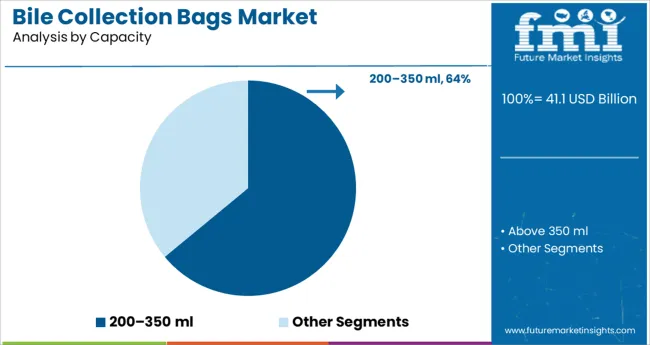
Bile collection bags with a capacity range of 200-350 ml are expected to hold 64.0% of the market revenue share in 2025, positioning this as the leading capacity segment. This dominance is being attributed to the compatibility of this volume range with standard post-surgical bile drainage requirements, balancing both patient comfort and clinical utility.
Bags within this range are considered ideal for ambulatory and short-stay procedures, where excessive fluid retention is uncommon but continuous drainage is essential. Their moderate size also supports discreet patient use, ease of securement, and reduced risk of leakage or backflow.
The segment’s growth is further supported by the trend toward smaller, single-use medical devices, which facilitate better hygiene compliance, quicker turnover in hospital settings, and streamlined inventory management for procurement teams.

By material type, non-latex bile collection bags are projected to account for 71.0% of the total market revenue in 2025. This segment’s leadership is being reinforced by increasing awareness of latex allergies among both patients and healthcare workers, which has led to a systematic phase-out of latex-containing products in many clinical environments.
Non-latex materials, such as silicone and synthetic polymers, offer high flexibility, durability, and inertness, making them suitable for prolonged contact with biological fluids. These materials also support clearer volume gradations and better visual inspection of contents, enhancing clinical usability. Additionally, non-latex solutions are aligned with infection control best practices, as they often allow for better sealing and sterilization methods.
As regulatory guidelines and hospital procurement policies increasingly favor hypoallergenic and biocompatible materials, non-latex variants continue to gain traction across major healthcare systems.
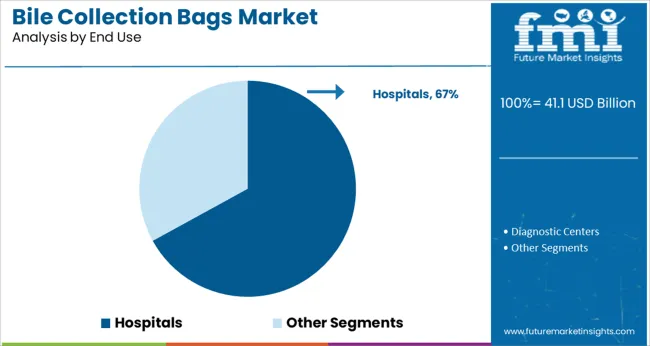
Hospitals are projected to represent the dominant end-use segment in the bile collection bags market, with a 67.0% revenue share expected in 2025. This dominance is driven by the high volume of inpatient surgeries, biliary drainage procedures, and post-operative care performed in hospital settings. Hospitals require consistent, large-scale procurement of sterile, single-use bile collection bags that meet both performance and safety criteria, particularly in surgical wards and intensive care units.
The need for precision fluid monitoring, reduced risk of nosocomial infections, and strict compliance with medical waste disposal standards further supports demand for high-quality collection systems. The hospital segment’s leadership is also reinforced by structured budgeting and bulk purchasing practices, which prioritize reliability, traceability, and cost-efficiency.
With increasing adoption of enhanced recovery after surgery (ERAS) protocols, the role of bile collection bags in patient monitoring and recovery is expected to become even more critical in hospital care pathways.
Bile collection bags are mainly used for the process of bile drainage. Bile drainage involves the insertion of a tube in the liver to extract the bile juice. Bile collection bags are used across diagnostic centres and pathology labs and are usually made of plastic and elastomers.
Apart from the bile juice, they are also used for the collection of gastric secretions. Bile collection bags market is expected to grow over the forecast period due to rising prevalence of liver related disorders. The growth of the global bile collection bags is also expected to expand due to growing demand for laparoscopic cholecystectomy.
Since there is a rising prevalence of chronic diseases worldwide, the global bile collection bags market is expected to be driven by the high demand in surgical procedures. Bile collection bags facilitate the easy collection of bile and other gastric secretions which is further anticipated to bolster the demand of the global market.
Additionally, the increase in the geriatric population globally is also leading to surging demand for bile collection bags market. Moreover, the government of emerging economies is providing the facility of an easy access to the bile collection bags which is expected to open up new market opportunities for growth of the global bile collection bags market.
The growth of the global bile collection bags market is hampered by an increased risk of cross contamination and strict government regulations concerning the efficacy and safety of these bags is expected to hamper the growth of the global bile collection bags market.
High taxation on the healthcare devices is also expected to restrain the growth of the global bile collection bags market. Use of raw materials that are rendered safe for environment is expected to open up new avenues of market growth for the global bile collection bags market.
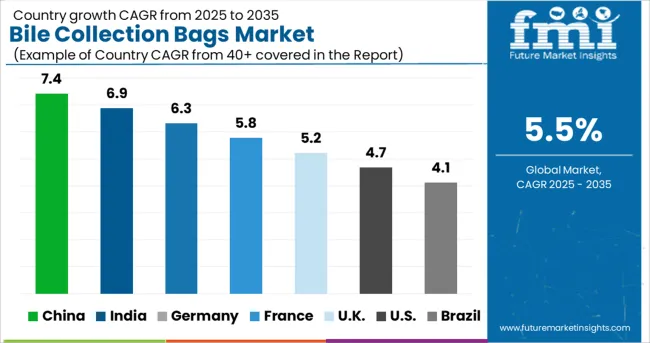
The global bile collection bags market is segmented on the basis of the region into North America, Europe, Asia Pacific, Middle East & Africa (MEA), and Latin America. North America is expected to lead the global bile collection bags market attributed to a well-established healthcare industry along with a health concerned population base.
Asia Pacific bile collection bags market is expected to expand at the highest CAGR over the forecast period due to rising technological innovations among the healthcare organizations in the region. Economy like India in the APAC region represents a high number of liver related disorders wherein the bile collection bags are expected to find their maximum consumption.
Europe bile collection bags market is expected to witness moderate growth over the forecast period. The region is expected to grow at a slow pace as compared to Asia Pacific due to down turning economy in certain regions. Middle East & Africa is expected to witness sluggish growth due to comparatively low GDP and a low percentage of healthcare expenditure.
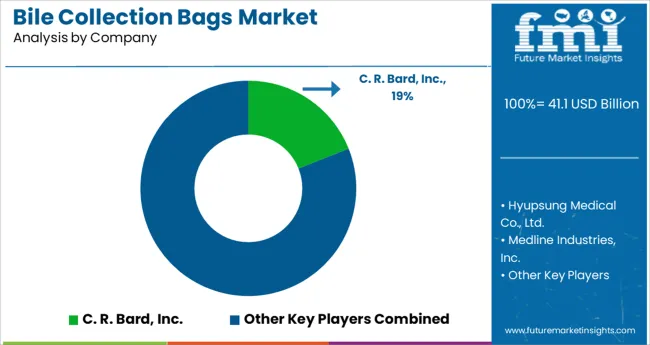
Some of the key players operating in the global bile collection bags market are Hyupsung Medical Co., Ltd., C. R. Bard, Inc., Medline Industries, Inc., Baxter International Inc., Fresenius Medical Care AG & Co., and Redax.
The research report presents a comprehensive assessment of the market and contains thoughtful insights, facts, historical data, and statistically supported and industry-validated market data.
It also contains projections using a suitable set of assumptions and methodologies. The research report provides analysis and information according to categories such as market segments, geographies, types, technology and applications.
The report is a compilation of first-hand information, qualitative and quantitative assessment by industry analysts, inputs from industry experts and industry participants across the value chain.
The report provides in-depth analysis of parent market trends, macro-economic indicators and governing factors along with market attractiveness as per segments. The report also maps the qualitative impact of various market factors on market segments and geographies.
The global bile collection bags market is estimated to be valued at USD 41.1 billion in 2025.
It is projected to reach USD 70.2 billion by 2035.
The market is expected to grow at a 5.5% CAGR between 2025 and 2035.
The key product types are 200–350 ml and above 350 ml.
non latex segment is expected to dominate with a 71.0% industry share in 2025.






Our Research Products

The "Full Research Suite" delivers actionable market intel, deep dives on markets or technologies, so clients act faster, cut risk, and unlock growth.

The Leaderboard benchmarks and ranks top vendors, classifying them as Established Leaders, Leading Challengers, or Disruptors & Challengers.

Locates where complements amplify value and substitutes erode it, forecasting net impact by horizon

We deliver granular, decision-grade intel: market sizing, 5-year forecasts, pricing, adoption, usage, revenue, and operational KPIs—plus competitor tracking, regulation, and value chains—across 60 countries broadly.

Spot the shifts before they hit your P&L. We track inflection points, adoption curves, pricing moves, and ecosystem plays to show where demand is heading, why it is changing, and what to do next across high-growth markets and disruptive tech

Real-time reads of user behavior. We track shifting priorities, perceptions of today’s and next-gen services, and provider experience, then pace how fast tech moves from trial to adoption, blending buyer, consumer, and channel inputs with social signals (#WhySwitch, #UX).

Partner with our analyst team to build a custom report designed around your business priorities. From analysing market trends to assessing competitors or crafting bespoke datasets, we tailor insights to your needs.
Supplier Intelligence
Discovery & Profiling
Capacity & Footprint
Performance & Risk
Compliance & Governance
Commercial Readiness
Who Supplies Whom
Scorecards & Shortlists
Playbooks & Docs
Category Intelligence
Definition & Scope
Demand & Use Cases
Cost Drivers
Market Structure
Supply Chain Map
Trade & Policy
Operating Norms
Deliverables
Buyer Intelligence
Account Basics
Spend & Scope
Procurement Model
Vendor Requirements
Terms & Policies
Entry Strategy
Pain Points & Triggers
Outputs
Pricing Analysis
Benchmarks
Trends
Should-Cost
Indexation
Landed Cost
Commercial Terms
Deliverables
Brand Analysis
Positioning & Value Prop
Share & Presence
Customer Evidence
Go-to-Market
Digital & Reputation
Compliance & Trust
KPIs & Gaps
Outputs
Full Research Suite comprises of:
Market outlook & trends analysis
Interviews & case studies
Strategic recommendations
Vendor profiles & capabilities analysis
5-year forecasts
8 regions and 60+ country-level data splits
Market segment data splits
12 months of continuous data updates
DELIVERED AS:
PDF EXCEL ONLINE
Mobile Camping Toilet Market Size and Share Forecast Outlook 2025 to 2035
Mobile Phone Screen Underlayer Cushioning Material Market Size and Share Forecast Outlook 2025 to 2035
Mobile Application Store Market Size and Share Forecast Outlook 2025 to 2035
Mobile Money Market Forecast and Outlook 2025 to 2035
Mobile Application Testing Solution Market Size and Share Forecast Outlook 2025 to 2035
Mobile Cardiac Telemetry System Market Size and Share Forecast Outlook 2025 to 2035
Mobile Robots Market Size and Share Forecast Outlook 2025 to 2035
Mobile Crane Market Size and Share Forecast Outlook 2025 to 2035
Mobile Vascular Imaging Market Size and Share Forecast Outlook 2025 to 2035
Mobile Animal Inhalation Anesthesia Machine Market Size and Share Forecast Outlook 2025 to 2035
Mobile Unified Communications and Collaboration (UC&C) Solution Market Size and Share Forecast Outlook 2025 to 2035
Mobile Data Protection Market Size and Share Forecast Outlook 2025 to 2035
Mobile Medical Tablets Market Size and Share Forecast Outlook 2025 to 2035
Mobile WLAN Access Points Market Size and Share Forecast Outlook 2025 to 2035
Mobile Social Networks Market Size and Share Forecast Outlook 2025 to 2035
Mobile Printer Market Size and Share Forecast Outlook 2025 to 2035
Mobile Application Development Platform Market Size and Share Forecast Outlook 2025 to 2035
Mobile Threat Management Security Software Market Size and Share Forecast Outlook 2025 to 2035
Mobile Broadband Infrastructure Market Size and Share Forecast Outlook 2025 to 2035
Mobile Enterprise Application Development Platform Market Size and Share Forecast Outlook 2025 to 2035

Thank you!
You will receive an email from our Business Development Manager. Please be sure to check your SPAM/JUNK folder too.
Chat With
MaRIA